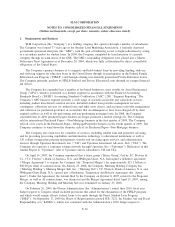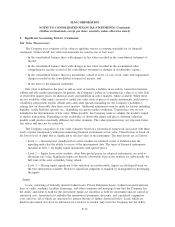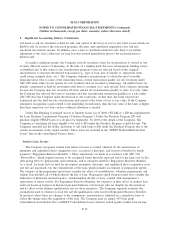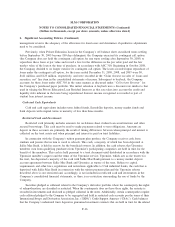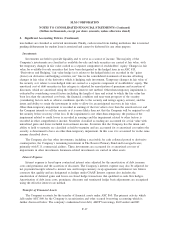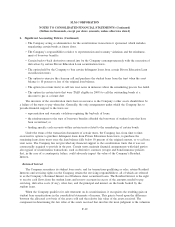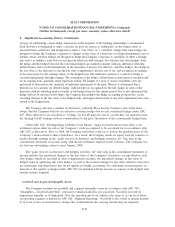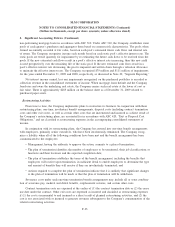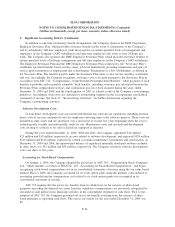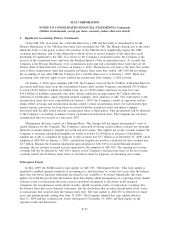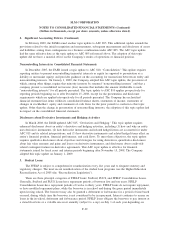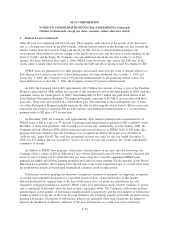Sallie Mae 2009 Annual Report Download - page 147
Download and view the complete annual report
Please find page 147 of the 2009 Sallie Mae annual report below. You can navigate through the pages in the report by either clicking on the pages listed below, or by using the keyword search tool below to find specific information within the annual report.2. Significant Accounting Policies (Continued)
of the Residual Interest. The Company estimates the fair value of the Residual Interest, both initially and each
subsequent quarter, based on the present value of future expected cash flows using management’s best
estimates of the following key assumptions — credit losses, prepayment speeds and discount rates commensu-
rate with the risks involved. Quoted market prices are not available. The Company adopted ASC 825,
“Financial Instruments,” effective January 1, 2008, whereby the Company elected to carry all Residual
Interests at fair value with subsequent changes in fair value recorded in earnings. The Company chose this
election in order to simplify the accounting for Residual Interests under one accounting model.
The fair value of the Fixed Rate Embedded Floor Income is a component of the Residual Interest and is
determined both initially at the time of the sale of the student loans and each subsequent quarter. This estimate
is based on an option valuation and a discounted cash flow calculation that considers the current borrower
rate, Special Allowance Payment (“SAP”) spreads and the term for which the loan is eligible to earn Floor
Income as well as time value, forward interest rate curve and volatility factors. Variable Rate Floor Income
received is recorded as earned in securitization income.
The Company also receives income for servicing the loans in its securitization trusts which is recognized
as earned. The Company assesses the amounts received as compensation for these activities at inception and
on an ongoing basis to determine if the amounts received are adequate compensation as defined in ASC 860.
To the extent such compensation is determined to be no more or less than adequate compensation, no
servicing asset or obligation is recorded at the time of securitization. Servicing rights are subsequently carried
at the lower of cost or market. At December 31, 2009 and 2008, the Company did not have servicing assets or
liabilities recorded on the balance sheet.
Derivative Accounting
The Company accounts for its derivatives, which include interest rate swaps, cross-currency interest rate
swaps, interest rate futures contracts, interest rate cap contracts, Floor Income Contracts and equity forward
contracts in accordance with ASC 815, “Derivatives and Hedging,” which requires that every derivative
instrument, including certain derivative instruments embedded in other contracts, be recorded at fair value on
the balance sheet as either an asset or liability. Derivative positions are recorded as net positions by
counterparty based on master netting arrangements (see Note 9, “Derivative Instruments,” under Risk
Management Strategy) exclusive of accrued interest and cash collateral held or pledged. The Company
determines the fair value for its derivative contracts primarily using pricing models that consider current
market conditions and the contractual terms of the derivative contract. These factors include interest rates,
time value, forward interest rate curve, volatility factors, forward foreign exchange rates, and the closing price
of the Company’s stock (related to its equity forward contracts). Inputs are generally from active financial
markets; however, adjustments are made to derivative valuations for inputs from illiquid markets, and for
credit for both when the Company has an exposure to the counterparty net of collateral held and when the
counterparty has exposure to the Company net of collateral pledged. The fair values of some derivatives are
determined using counterparty valuations. Pricing models and their underlying assumptions impact the amount
and timing of unrealized gains and losses recognized with regard to derivatives, and the use of different
pricing models or assumptions could produce different financial results. As a matter of policy, the Company
compares the fair values of its derivatives that it calculates to those provided by its counterparties. Any
significant differences are identified and resolved appropriately.
Many of the Company’s derivatives, mainly interest rate swaps hedging the fair value of fixed-rate assets and
liabilities, cross-currency interest rate swaps, and certain Eurodollar futures contracts, qualify as effective hedges
under ASC 815. For these derivatives, the relationship between the hedging instrument and the hedged items
(including the hedged risk and method for assessing effectiveness), as well as the risk management objective and
F-20
SLM CORPORATION
NOTES TO CONSOLIDATED FINANCIAL STATEMENTS (Continued)
(Dollars in thousands, except per share amounts, unless otherwise stated)


